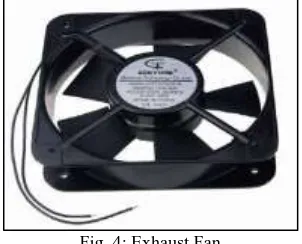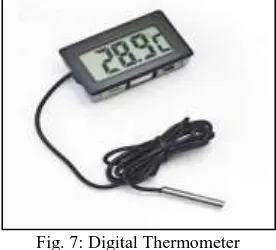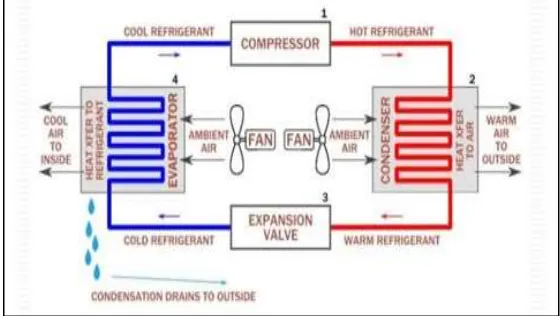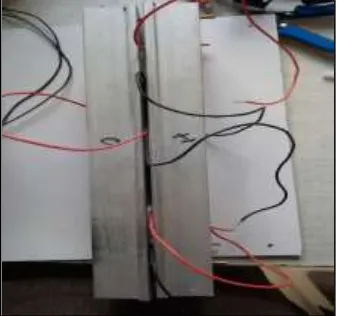Development of Non Refrigerant Air Conditioner
using Peltier Thermoelectric Module
M. Divya K. Saravanan
UG Student UG Student
Department of Electronics & Communication Engineering Department of Electronics & Communication Engineering
SNS College of Technology, Coimbatore SNS College of Technology, Coimbatore
R. Poorani T. Ravichandran
UG Student Dean
Department of Electronics & Communication Engineering Department of Electronics & Communication Engineering
SNS College of Technology, Coimbatore SNS College of Technology, Coimbatore
Abstract
In this paper, an air conditioner has been constructed using peltier thermoelectric module which is attractive for upcoming technologies. Thermoelectric modules are widely used in product areas such as from simple coolers to temperature control systems in military and telecommunications organizations. Here, the construction of an air conditioner using peltier thermoelectric module has been presented.
Keywords: Peltier effect, Thermoelectric module, Switched mode power supply, PN Diode, Chloroflurocarbon, Refrigerants
_______________________________________________________________________________________________________
I. INTRODUCTION
An air conditioner is an device which removes warm air and replaces it with cooler and humid air with the help of refrigeration cycle. The process of removing heat from space and cooling the space’s temperature is called as air conditioning. Air conditioning means heating, cooling, (de-)humidification, cleaning, and ventilation or air movement i.e any form of technology that can be used to modify the condition of air. In short, the purpose of air conditioner is to provide comfort by altering the properties of air, mainly by cooling the air.
II. BACKGROUND
Switched Mode Power Supply
The switching regulator integrated with the electronic power supply for the conversion of electrical power from one form to another form which desired characteristics is called as switched mode power supply. SMPS transfers power from a DC or AC source to DC loads such us personal computers. It converts voltage and current characteristics. The pass transistor of a switching mode supplies continually switches between low dissipation, full-on and full-off states, and spends very less time in the high dissipation transitions. By this way, it minimizes the wasted energy. Theoretically, there is no power dissipation in the switched mode power supply.
Fig. 1: Switched Mode Power Supply
Thermoelectric Coolers
materials which can be used instead of Bismuth Telluride are Lead Telluride(PbTe), Silicon Germanium(SiGe) and Bismuth Antimony(Bi-Sb). These alloys can be used in different situations.
Thermoelectric coolers are made up of two or more elements of semiconductors materials which are connected electrically in series and thermally in parallel. Between the ceramic substrates, the thermoelectric elements and their electrical interconnections are mounted. The substrate’s purpose is to hold the overall structure together mechanically and to insulate the individual elements electrically to one another and from external mounting surfaces. The size of the modules range from 50mm square and 2.5-5mm in height approximately.
Fig. 2: Thermoelectric module
Blower Fan
The blower fan is also called as centrifugal fan or squirrel-caged fan. It is a mechanical device used for moving air or other gases in any surroundings. The rotating impellers in the fans is used to increase the speed and volume of air stream. These fans move a constant volume of air through it instead of constant mass, this way it leads to the constant fan speed.
Fig. 3: Blower Fan
Exhaust Fan
It is a fan which is used to remove moisture out of a room. It helps to remove any odors. The primary purpose of the exhaust fan is to control the interior environment by venting out smoke and other contaminants which may be present in the air. It can be integrated into a cooling or heating system. It disperses the air harmlessly. It can be used in summers to push warm air out for temperature controlling. It can be used as an alternative for air conditioner.
Fig. 4: Exhaust Fan
Transformer
the magnetic field is also changed, this in turn, induces a electromagnetic force in a second coil. It is used in electric and electronic power applications by increasing or decreasing the alternating voltages.
Fig. 5: Transformer
Heat Sink
It is a passive heat exchanger which transfers the heat produced by any electronic devices to air or liquid medium to maintain a constant temperature throughout. It is mostly used with high-power semiconductor devices which has low heat dissipation ability. It is made up of copper or aluminum.
Fig. 6: Heat sink
Digital Thermometer
It is a device which is used to measure temperature. It is easily portable. It has permanent probes and a digital display. Its function depends upon the type of sensors used.
Fig. 7: Digital Thermometer
III. CONVENTIONAL AIR CONDITIONING SYSTEM
Working Principle
heat is removed from the system and is carried away by air. The heat can also be removed by pouring water over the condenser coil making it much cooler, before it reaches the expansion valve. Here, it undergoes reduction in pressure and causes flash evaporation of the liquid refrigerant resulting in lowering the temperature. It is then passed to the evaporator. A fan is used to blow the warm air and the liquid part of the refrigerant mixture to evaporate, causing further lowering temperature.This way, the warm air is cooled.
Fig. 8: Block Diagram of Conventional Air conditioner
Drawbacks
Effects of CFC on humans
Chloroflurocarbons (CFCs) are highly stable compounds that were used as propellants in refrigeration units. It is compose of several organic compounds such as carbon, fluorine, chlorine and hydrogen. It is also called as Freon.
CFCs help in the growth of microorganisms, such as Legionella pneumophila, the infectious agent responsible for Legionnaires’ disease or thermophilicactinomytes. It is only caused in poorly maintained water cooling towers. The concentration of the stratospheric ozone has decreased resulting in increase of skin cancer and genetic damages in many organisms.
Effects of CFC in environment
The release of greenhouse gases by CFC has an environmental impact. This is called as greenhouse effect. It is the process by which the planet’s surface warms up and it increases the temperature of the atmosphere. The greenhouse effect makes lifes on the Earth critical by increasing the atmospheric carbon dioxide levels. It has resulted in climate changes.
Ozone Depletion
Most refrigerants used in the air conditioning system causes depletion in the ozone layer. CFC is the potent greenhouse gas when leaked to the atmosphere. Once, it reaches the stratosphere, the ultraviolet radiation breaks the CFC and introduces chlorine into the ozone layer. Under proper conditions, chlorine can destroy large amount of ozone which shields the Earth’s surface. The chlorine acts as a catalyst and forms a chain reaction.
Chemical equation-
CFCl3+UV Light CFCl2+Cl Cl+O3ClO+O2
ClO+OCl+O2
The free chlorine atom is free to attack another ozone molecule. Cl+O3ClO+O2
ClO+OCl+O2 And again.
IV. ADVANCED THERMOELECTRIC MODULE BASED COOLINGPELTIER EFFECT
The peltier effect converts temperature differnces to electric voltage by using a thermocouple. It creates an electric voltage when there is a difference in the temperature on both sides of the thermocouple. It also does the vice versa process i.e when a voltage is applied to the thermocouple, the temperature difference is created on each side. The direction of heating and cooling is determined by the polarity of the applied voltage. This effect can be used for generating electricity, measuring temperature or change the temperature of objects.
Advantages
Cost Analysis
In conventional air conditioner, the cost of refrigerant gas is high. The conditioner has to be maintained regularly and hence, there is also a maintenance cost. The refrigerant gases should be filled regularly and it costs service charge. But in the advanced thermoelectric module cooling, there is no refrigerant gases and the maintenance needed is also less. Hence it is cost effective compared to conventional air conditioner.
Working
PN Diode
Two semiconductors, one n-type and another p-type has been used because of the difference in the electron densities. The semiconductors are placed thermally in parallel to each other and electrically in series and then joined with a thermally conducting plate on each side.
Fig. 9: PN Junction Diode
Heating/Cooling Process
When a voltage is applied to the free ends of the two semiconductors, there is a DC current flow across the junction of the semiconductors causing a temperature difference. The side with the cooling plate absorbs heat and transfers to heat sink. Thermoelectric coolers are placed between two ceramic plates. The cooling increases with increase in the thermoelectric modules.
V. RESULTS &DISCUSSION
From all the above discussions, it is seen that thermoelectric module cooling is more advantageous than the conventional air conditioner.
VI. CONCLUSION
In this paper, working of the conventional air conditioner and the advantages of the thermoelectric module cooling has been discussed. In future, a thermoelectric module based cooling can cool 10x10 rooms with only few modules in a very less time.
REFERENCES
[1] Harb, “Energy harvesting: state-of-the-art,” Renewable Energy, vol. 36, no. 10, pp. 2641-2654, 2011. [Online]. Available:v:36:y:2011:i:10:p:2641-2654. [2] S. Dalola, M. Ferrari, V. Ferrari, M. Guizzetti, D. Marioli, and A.Taroni, “Characterization of thermoelectric modules for powering autonomous sensors,”
IEEE Trans. Instrum. Meas., vol. 58, no. 1,pp. 99-107, Jan. 2009. DOI: 10.1109/TIM.2008.928405.
[3] M. T. Barako, W, Park, A. M. Marconnet, M. Asheghi, and K.E. Goodson, “A reliability study with infrared imaging of thermoelectric module under thermal cycling,” in Proc. IEEE
[4] Intersociety Conf. on Thermal and Thermomechanical Phenomena in Electron. Syst. (ITherm), pp. 86-92, May 2012. H. C. R. L. Tenorio, D. A. Vieira, C. P. de Souza, E. C. T. de Macêdo and R. C. S. Freire, “A thermoelectric module thermal-cycling testing platform with automated measurement capabilities,” in Proc. IEEE Int. Instrum. Meas. Technology Conf., pp. 1-5, 2016. DOI: 10.1109/I2MTC.2016.7520326.
[5] M. T. Barako, W. Park, A. M. Marconnet, M. Asheghi, and K. E. Goodson, “Thermal cycling, mechanical degradation, and the effective figure of merit of a thermoelectric module,” J. Electron. Materials, vol. 42, no. 3, pp. 373-381, 2012.
[6] J. C. de C. Veras, B. W. de S. Arruda, D. A. Vieira, E. C. S. Melo, C. S. de Souza, “An automatic thermal cycling based test platform for thermoelectric generator testing,” IEEE Int. Instrum. Meas. Technology Conf., vol. 1. pp. 1949-1953, May 2015.
[7] L. Shen, F. Guo, N. Zheng, and R. Zhao, “The effects of isothermal aging on sandwich structural of p- and n-TE/Ni/SBA/Cu joints,” inProc. Int. Conf. Electron. Packaging Technology & High Density Packaging, 2012
[8] J. W. McPherson, Reliability Physics and Engineering - Time-To-Failure Modeling, New York, NY, USA: Springer US, 2010.
[9] G. Naveen Balaji, D. Rajesh “Smart Vehicle Number Plate Detection System for Different Countries Using an Improved Segmentation Method” Imperial Journal of Interdisciplinary Research (IJIR) Vol. 3, No. 6, 2017, pp. 263-268. ISSN: 2454-1362
[10] G. Naveen Balaji, N.V. Hari Suriya, S. AnandVikash, R.Arun, S. Arun Kumar “Analysis of Various Liquid Components under Different Temperature and Density Constraints Pertaining To Fractional Distillation” Imperial Journal of Interdisciplinary Research (IJIR) Vol. 3, No. 6, 2017, pp. 664-669. ISSN: 2454-1362
[11] G. Naveen Balaji, D. Rajesh “Python Based Reverse Timing Algorithm for Human Brain Activity Using Color Psychology” International Journal of Indian Psychology, Vol. 4, No. 3, DIP: 18.01.111/20170403, pp: 79-86, ISSN 2348-5396
[12] G. Naveen Balaji, S. Chenthur Pandian, D. Rajesh “High Performance Triplex Adder Using CNTFET” International Journal of Trend in Scientific Research and Development, Vol.1, No. 5, pp: 368-373, ISSN 2456 - 6470
[13] G. Naveen Balaji, S. Chenthur Pandian, S. Giridharan, S. Shobana, J. Gayathri “Dynamic and Non-Linear Charge Transfer Through Opto-Deportation by Photovoltaic Cell” International Journal of Trend in Scientific Research and Development, Vol. 1, No. 5, pp: 486-492, ISSN 2456 - 6470
[14] G. Naveen Balaji, S. Karthikeyan, M. Merlin Asha “ 0.18μm CMOS Comparator for High-Speed Applications” International Journal of Trend in Scientific Research and Development, Vol. 1, No. 5, pp: 671-674, ISSN 2456 - 6470
[15] G. Naveen Balaji, K. Saravanan, R. Poorani, T. Vishnu Priya, R. Reka Raj “Advanced Security System using PIC through Bluetooth” International Journal of Trend in Scientific Research and Development, Vol. 1, No. 5, pp: 675-685, ISSN 2456 - 6470
[16] G. Naveen Balaji, N.V. Hari Suriya, S. Anand Vikash, S. Arun Kumar, R. Arun, “Gasoline Purity Meter Using Peripheral Interface Controller for Automobile Applications” International Journal of Engineering and Technical Research (IJETR), Vol. 7, No.10, pp:46-55, ISSN: 2321-0869
[17] G. Naveen Balaji, S.Chenthur Pandian, “Design for Testability of Kipbond Logic” “Perspectivas em Ciência da Informação” (Annexure - I), School of Information Science of the Federal University of Minas Gerais (UFMG), Vol. 22, No. SP.01, pp: 261-284, ISSN 1413-9936
[18] G. Naveen Balaji, V. Nandhini, S. Mithra, N. Priya , R. Naveena, “IOT Based Smart Crop Monitoring in Farm Land”, Imperial Journal of Interdisciplinary Research (IJIR) Vol. 4, No. 1, pp: 88-92, ISSN: 2454-1362
[19] G. Naveen Balaji, N. V. Hari Suriya, “Effective Badminton Coaching Schema using PIC16F887 Microcontroller”, International Journal of Trend in Scientific Research and Development, Vol. 2, No. 2, pp: 178 – 182, ISSN 2456 - 6470
[20] G. Naveen Balaji, S. Chenthur Pandian, “Power Analysis of a Transmission Gate based Scan Flip Flop”, International Journal of Engineering Research in Electronics and Communication Engineering (IJERECE) Vol 4, Issue 11, November 2017, pp:48-53, ISSN: 2394-6849
[21] P.Malini, T.Poovika, P.Shanmugavadivu, G.Naveen Balaji, “Design of High Speed 8 Bit Carry Look Ahead Logic for Arithmetic Operations”, International Journal of Engineering Research in Electronics and Communication Engineering (IJERECE) Vol 4, Issue 12, December 2017, pp:59-62, ISSN: 2394-6849 [22] G. Naveen Balaji, D.Rajesh, S. Sowmya, M. Subashini, P. Suryaprabha, “Power Analysis of an Approximate adders under various interpolation factors for
DSP Applications”, International Journal of Engineering and Technical Research, Vol. 8, Issue 1, January 2018, pp: 379 – 383, ISSN: 2321-0869
[23] G. Naveen Balaji, V. Nandhini, S. Mithra, N. Priya , R. Naveena “Advanced Crop Monitoring using Internet of Things based Smart Intrusion & Prevention in Agricultural Land” International Journal of Trend in Scientific Research and Development, Vol. 2, No. 2, pp: 1348-1352, ISSN 2456 – 6470




